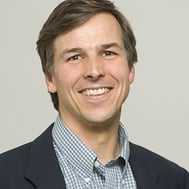Hello! And welcome to this episode of Insight to Go on the business cycle of leadership. I'm Nick Noyes, and for over 20 years, I’ve been designing and leading experiences to help leaders grow and become more effective by bringing together the "hard" and "soft" skills of leadership. I’m excited to talk to you today about the link between your own leadership and the business results you want to drive in your organization. This is the Business Cycle of Leadership, and let me give you an overview.
As leaders, we work to lead our teams and organizations to greater performance. It's helpful to understand that we operate in two highly interrelated systems at work: a business system and a people system. Both of these systems are at work in our environments all the time, sometimes visibly and sometimes invisibly. Today, I want to talk with you about a model that brings them together, and I hope it will provoke your thinking about how your leadership actions drive results not only for you but for your team and the entire organization.
Let me break it down for you. When I started in the corporate world, I learned that the business world more or less worked like this: You make organizational decisions, such as capital expenditures and operating decisions; allocate a budget; people do the work; and you get business results. These results then fund further decisions and budgets, creating a cycle that repeats itself. The only problem is that this model rests on one big assumption: It assumes that your people will faithfully execute and implement all of those decisions. However, as many of us know from real-world experience, this assumption is often flawed.
In reality, for this model to work, your people need to be both willing and able to execute on the investment and operating decisions you make as a leader. It rests more in their hands than yours. We believe, and research supports, that three things you do as a leader are key to creating conditions for success. These three simple things are:
-
What you say and how you say it.
-
How you spend your time and ask others to spend theirs.
-
The priorities and focus you set for the business, for others, and for yourself.
These three things, simple as they are, are key to creating the conditions for improved employee performance. They help drive engagement; alignment; and most importantly, discretionary effort. In other words, how you lead directly impacts the effectiveness of those operating decisions because they’re implemented by your team to actually drive business results. Note that these three things don’t require a budget or a specific level of authority—they are non-monetary and non-hierarchical. You can lead with these levers at any level of an organization.
It’s critical that what you say, how you spend your time, and the priorities you set for yourself and others be aligned with your own beliefs, values, and perspective as a leader. If they’re not aligned, they lack integrity, and people won’t believe or trust you. They certainly won’t follow you. This alignment helps you create a culture in your organization, and with that culture comes not only business results but also valuable feedback—perspectives and information—that come back to you as a leader.
Let’s spend a moment pressure-testing this feedback. If you build an environment of high trust, transparency, performance, and engagement, and you, as a leader, make a mistake, people in that environment are likely to tell you the truth. They’ll assume the best intent and say it was a well-intentioned action with unexpected outcomes, and they’ll want you to know. In other words, you get the benefit of the doubt. On the other hand, in a low-trust, low-engagement environment, people might tell you nothing. They may be afraid to speak up, or they may not care enough to bother because they think feedback won’t make a difference or might even be punished.
The problem with a lack of feedback is that you miss out on crucial information needed to run the business more effectively. As a leader, you must aggressively work to remove bias and get the unfiltered truth. To do this, you need to build a culture of trust and transparency. Without it, the higher you rise in an organization, the more filtered and less reliable the information you receive becomes, making it harder to make important decisions. This is a dangerous position for any leader, and it’s a common reason senior leaders become disconnected from their organizations.
To lead effectively, you must earn the trust of your people and build an environment where they feel comfortable bringing you feedback. This is essential for tapping into the full potential of your people, which will, in turn, show up visibly in both your business and people systems. You’ll see it in your work environment, productivity, engagement, and in the effectiveness of your organizational decisions.
I want to leave you with a question to ponder: What percentage of their true potential do you think people exercise at work every day? The Business Cycle of Leadership outlines a way to think about how to realize greater employee performance and build a culture of engagement, productivity, transparency, and trust. This can help you tap into greater potential for your people and greater results for your organization.

Nick Noyes
Nick Noyes is a co-founder and partner of Insight Experience. He has more than 20 years of experience working with clients on education and strategic change initiatives. His work spans many activities, including the design of simulation-based educational programs, executive facilitation, coaching, and action learning initiatives. In addition to the leadership he provides for Insight Experience and its clients, Nick is responsible for the company’s strategy, business development, and marketing efforts.









